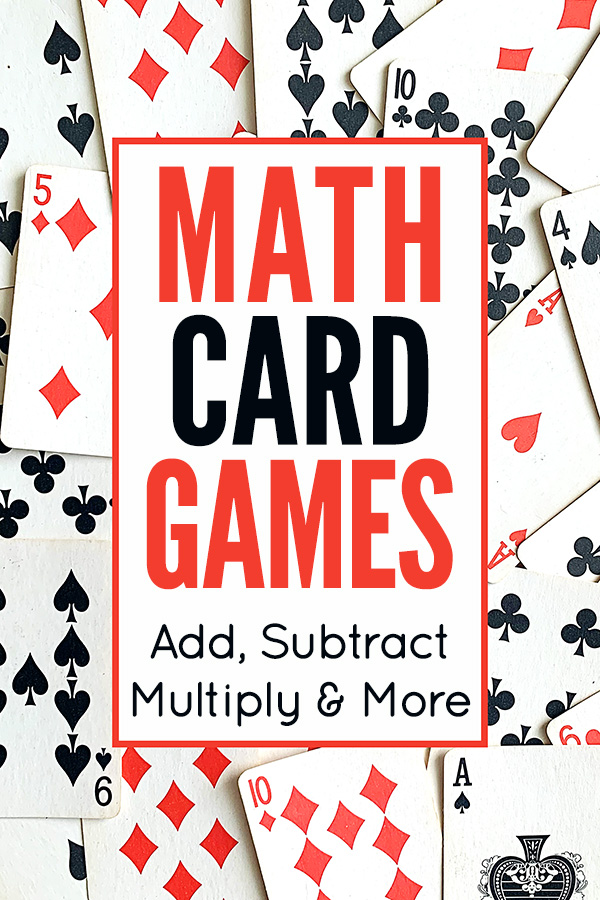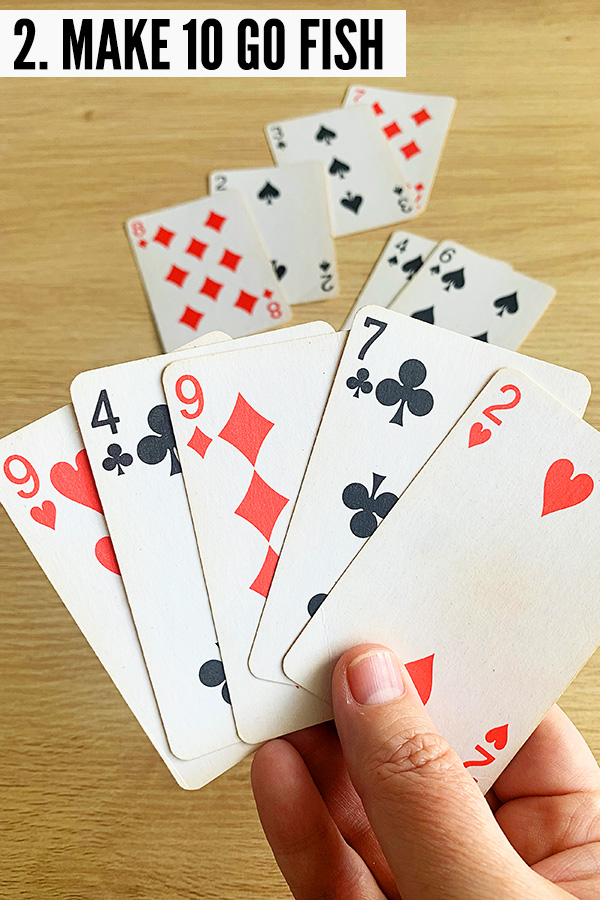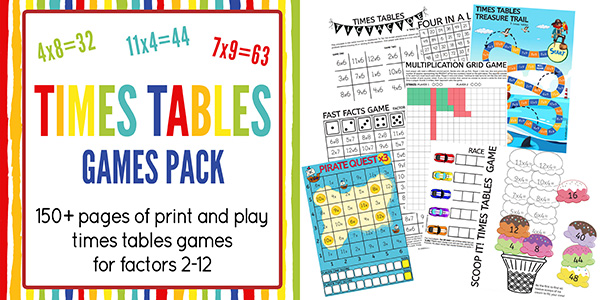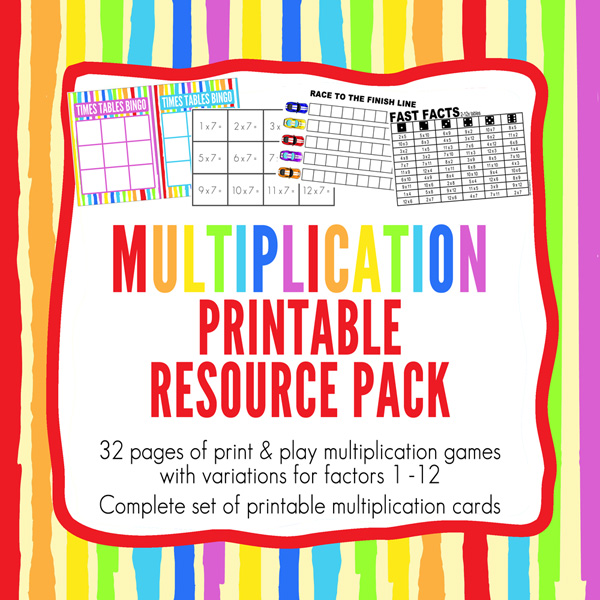Kids Math Card Games With Just a Deck of Cards!
Whether comparing numbers, adding, subtracting, dividing or multiplying, one simple deck of cards can be used to play countless math games, which is fabulous for the revision of multiple math skills. This collection of kid friendly math card games is likely to include some that are familiar and some new, and they’re all good for reinforcing important mathematical concepts through game play.
Did you know? Playing cards first appeared in Europe sometime between the 1300 and 1400s? Playing cards have a long history indeed.
Each of these games and activities can be set up quickly, especially when the only supplies you need are playing cards, and maybe a pencil and paper.
For each of these games, remove the Jacks, Queens, Kings and Jokers from the deck, leaving the ace (as one) and number cards to play with. Shuffle the deck well before commencing play.
Are you ready? It’s time to get shuffling!
9 Kid Friendly Math Card Games
1. Make Ten (or Fifteen or Twenty, etc)
Supplies: Ten pairs of playing cards that add up to ten (or you choice of target number)
To play:
- Can be played with one to four players.
- Lay out all twenty playing cards on the table face down.
- Youngest player goes first (or rock, paper, scissors to determine who goes first). Players take turns to turn over a pair of cards, with the aim of finding a pair of cards that add up to ten (or the target number).
Variations: Use fewer cards or smaller target number for younger players.
2. Make Ten Go Fish
To play:
- A game for two or more players (though it’s much more fun with three to five), deal five cards to each player. The remaining cards are stacked face down.
- The aim of the game is to collect pairs of cards with a total sum of 10. Any pairs of cards with a total sum of 10 that a player holds from the initial deal can be placed on the table.
- The first player then asks any other player for a card. For example, “I have a three, Dad please give me a seven.” The player making the request must already have a three card in her hand.
- The player being asked must hand over the card being requested (in this example, a seven) if he has one. The first player has now created a Make 10 pair and removes those two cards from her hand and places them on the table.
- If the player being asked does not hold the card being requested, he says, “Go fish.” In this instance, the first player must then draw a card from the centre stack. If the card drawn creates a Make 10 pair, the pair of cards can be placed on the table.
- Play moves clockwise around the table to the next player who can then request a card from any other player.
- Play continues until either someone has no cards left in their hand or the draw pile runs out. The winner is the player who has created the most Make 10 pairs.
3. Math Facts
A great way to revise learning about any of the three basic math facts – addition, subtraction or multiplication.
To play:
- A single player activity, start by dividing a deck of cards into two piles of cards face down on the table top. The player turns over the top card on each stack and adds, subtracts or multiplies the two cards to calculate the total.
4. Red or Black
A great math card game for practising addition and subtraction.
Supplies:
As well as your deck of cards you will need a piece of paper and a pencil.
To play:
This can be played as an independent practice task or a competitive game. When playing with more than one player, split the deck evenly between players. Play begins with each player’s deck stacked face down and a beginning score of 10 written at the top of their paper.
Each player flips their top card. If it is a red card the number is added to the player’s score, if it is a black card the number is subtracted from the score. The player writes the equation and new total score on their paper and draws another card. Play continues in this manner for 20 rounds. If playing competitively, the winner of the game is the person with the highest score at the end of the game.
5. Close Call
To play:
- A game for two players, each player is dealt four cards. The player arranges their four cards in any combination to make an addition problem whose sum is as close to 100 as possible without going over 100. The winner of the round is the person with the sum closest to 100.
Variation: Using four cards, make a subtraction problem from 100, with the winner of the round the closest to zero.
RELATED: Click through to find our collection of Brain Games and Logic Puzzles for kids.
6. Thirty-Six
To play:
- A game for up to four players, each player is dealt four cards.
- Using addition, subtraction, multiplication and division, players try to reach a total of 36. Each player who makes 36 scores a point. The winner is the first player to ten points.
Variation: Increase difficulty by incorporating order of operations (BIMDAS or PEMDAS)
7. Hit the Target
To play:
- A game for two or more players. The dealer deals three cards to each player which are lined up face up on the table in front of the player.
- The dealer then turns the next card from the deck and places it in the middle of the table. This is the target number.
- Trying to use all three of their cards and any of the four basic math operations, each player tries to make the target number. For example, if the target number is 7 and a player holds 9, 2 and 4, they can reach the target number with the equation 9-4+2=7.
- The winner of the round (if any) is the person who can make the target number and they score a point before new cards are dealt for the next round. Winner of the game is the first player to ten points.
Variation: Players are dealt five cards and must use at least two to reach the target number.
8. Once Through the Deck
A super simple times table game for practicing tricky multiplication facts.
To play:
A single player game, the player chooses the multiplication fact they need to revise, say seven times tables. They start with the deck of cards stacked face down in front of them. The first card is flipped and the player says the product of the revealed number multiplied by seven. For example, the card is a 5, 5×7=35. This process is repeated for each of the cards in the deck.
For more times tables fun, click through for 150+ pages of print and play times tables games
9. War
War is a great, fast moving card game that can be used to practise a range of different operations and mathematical concepts.
To play the most basic version of War:
- A game for two players, the deck is divided in half and one half given to each player.
- Each player flips the top card of their deck and the player with higher number takes both cards.
- The winner is the person with the most cards at the end of the game.
Variations:
- Addition War: Each player splits their half of the deck into two stacks. The two top cards are flipped and added together. The player with the highest sum wins the round and takes all of the cards from the round.
- Click through here for instructions to play Place Value War.
- Click through here for instructions to play Multiplication War.
- Fraction War: Each player splits their half of the deck into two stacks. The two top cards are flipped and added together. The two cards become a fraction. The higher value fraction wins the round.
Got Lego? You might also enjoy our collection of 25 Lego Learning Activities.





